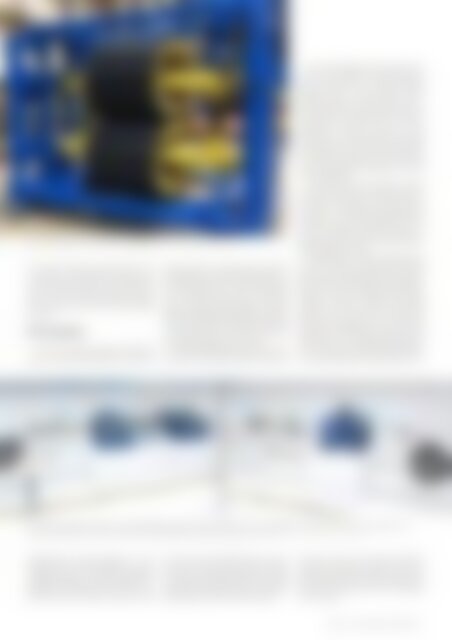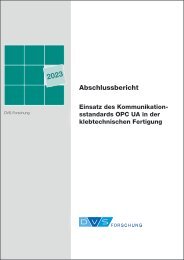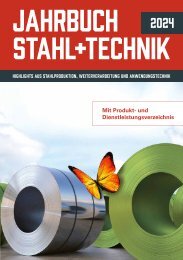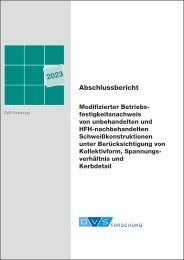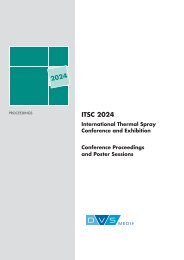STEEL + TECHNOLOGY 01/2020 EXTRACT
STEEL + TECHNOLOGY 01/2020 EXTRACT
STEEL + TECHNOLOGY 01/2020 EXTRACT
You also want an ePaper? Increase the reach of your titles
YUMPU automatically turns print PDFs into web optimized ePapers that Google loves.
50 | <strong>STEEL</strong> <strong>TECHNOLOGY</strong><br />
An Umlauf bridle shortly before installation (Picture: SES Engineering)<br />
the recoiler, adjusting a back-tension that<br />
is optimal for the specific recoiling process.<br />
A special feature of the Umlauf Bridle<br />
is that it can rotate through its vertical<br />
axis. This ensures perfectly straight-edged<br />
recoiling.<br />
First experience<br />
The line currently produces pickled &<br />
oiled, mild steel, high-carbon, HSLA and<br />
tension leveler. It is also extremely uniformly<br />
distributed over the entire strip width. The<br />
new line achieves up to 1.5% strip elongation<br />
normally and up to 3.0% on some products,<br />
an amount high enough to ensure<br />
effective levelling and descaling. Strip flatness<br />
has also been impressively improved:<br />
for example, strip of over 300 I Units flatness<br />
was levelled to just 10 I Units.<br />
A further advantage is that the strip is subjected<br />
to the correct strip tension as soon as<br />
Also the threading process has become<br />
much more reliable: the rotating crawler-type<br />
chains of the Umlauf Bridles<br />
securely “catch” the strip head – even if<br />
the heads bend up or downwards (ski formation).<br />
With the old equipment, threading<br />
usually took about 2 to 3 minutes.<br />
Sometimes manual intervention was<br />
required, often extending the time needed<br />
for threading to up to 30 minutes. Now<br />
every strip is threaded fully automatically<br />
within 45 seconds at a speed of up to 45<br />
m/min (150 FPM).<br />
As the second Umlauf Bridle actively<br />
pulls the strip through the leveler, the leveler<br />
does not require any drive equipment<br />
of its own. This reduces investment and<br />
maintenance costs and prevents the rollers<br />
from slipping. While strip tension is<br />
being built up, the first Umlauf Bridle operates<br />
in generator mode.<br />
Jeffery McLain, Finishing Mill Manager<br />
SDI is sure that the company took the right<br />
decision when opting for Umlauf technology:<br />
“Almost all our objectives have been<br />
fulfilled: we reach the high strip tensions<br />
needed to achieve excellent descaling<br />
results and to be able to level highstrength,<br />
thick-gage strips with the same<br />
high precision. We have reduced the time<br />
needed for strip threading dramatically.<br />
Our customers and downstream operations<br />
have reported that they prefer to run<br />
At the entry section (left) the two Umlauf Bridles produce strip tensions of up to 1,250 kN, whereas at the line run-out (right), the<br />
third Umlauf Bridle creates the back-tension needed to produce exactly wound coils (Picture: BTU Bridle Technology)<br />
AHSS steels in gages between 1.5 mm<br />
(0,060”) and 12.7 mm (0,500”) with yield<br />
strengths between 1,700 and 7,500 N/mm²<br />
(25,000 to 110,000 PSI). Strip tension is now<br />
triple the value it used to be with the old<br />
the second Umlauf Bridle bites the head of<br />
the strip. This means that, apart from about<br />
two meters at the head and tail, the strip is<br />
stretched immediately and over its complete<br />
length exactly with the tension required.<br />
material that has run through the Super-<br />
Leveler with the BTU Bridles. The sum of<br />
all these achievements has made our pickle<br />
line fit for the growing future challenges<br />
of the market.”<br />
<strong>STEEL</strong> + <strong>TECHNOLOGY</strong> 2 (<strong>2020</strong>) No. 1


